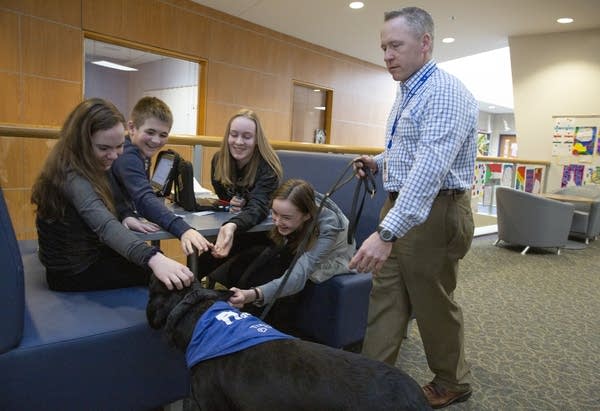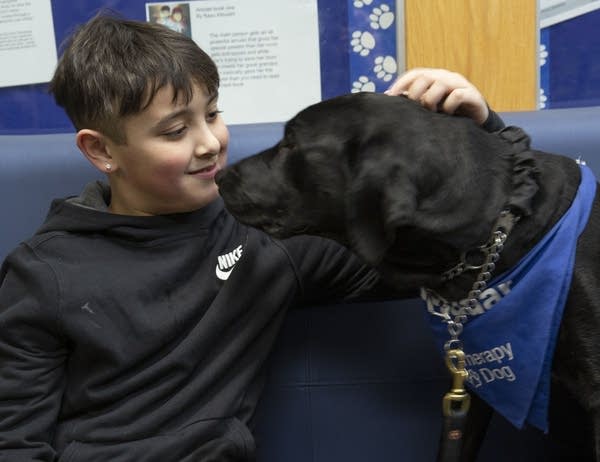Minnesota researchers say we're still getting school safety wrong

Go Deeper.
Create an account or log in to save stories.
Like this?
Thanks for liking this story! We have added it to a list of your favorite stories.
"It's been 20 years. This is not working."
That's Jillian Peterson's blunt assessment of the nation's reactions to school shootings since April 20, 1999, when two students opened fire inside Colorado's Columbine High School, killing 13, wounding 20 and destroying the belief in school as an oasis from gun violence.
Policy makers have spent billions of dollars since then on equipment to "harden" schools and on consultants to train kids to hide in place, but the deaths haven't stopped. Parkland, Sandy Hook and Red Lake are names as sadly familiar as Columbine; 2018 was a record year for deaths with 56 people killed in school shootings.
With the 20-year anniversary of Columbine approaching, Peterson, a Hamline University criminology professor, believes the nation needs to rethink the way America approaches school safety.
Turn Up Your Support
MPR News helps you turn down the noise and build shared understanding. Turn up your support for this public resource and keep trusted journalism accessible to all.
She and her colleague James Densley, a criminal justice professor at Metropolitan State University, say their research suggests the conventional wisdom on responding to these killings is wrong, and that a very different approach to school safety is needed.
"You can't stop something or prevent something from happening until you really understand why it's happening," Peterson said. "We've now hit a point where it's happened enough that we can actually start to create data and draw conclusions and use research to come up with policy ... our data gives some theory as to why it's not working."
Peterson walked MPR News through data she and Densley have collected, and the conclusions she said can be drawn about what works and what doesn't in school safety.
The researchers built a database of 160 mass public school shootings in the United States since 1966. They focused on the 45 of those shootings that have occurred in schools since Columbine.

Peterson said there's no single profile of a school shooter but there are patterns among those who have committed mass acts of gun violence at schools.
• 91 percent were current or former students of the school where the shooting took place.
• Many had a history of trauma and risk factors for crime and violence.
• 80 percent had expressed suicidal thoughts and had signs of a crisis before the shooting.
These patterns, combined with the increasing severity of mass school shootings, suggest to Peterson that the way America is trying to prevent school shootings is simply not working.
'We're really focused on security in schools — running lockdown drills, watching training videos, resource officers in schools," she said. "In Minnesota, we put a lot of money into building more secure buildings, more secure entry points ... we know that it's inadequate. It's not preventing school shootings."
'Script for violence?'
Lockdown drills top the list of security measures Peterson believes schools need to drop. She thinks training the adults in school on lockdown procedures, de-escalation and suicide prevention should happen without involving the kids.
The drills, she said, traumatize many students, and since most shootings come at the hands of current or former students, the routine may unwittingly offer a would-be shooter a blueprint on how to increase casualties.
"Are you handing a script for this type of violence at a really young age? Are we giving this to kids and training them on it ... sort of triggering a fascination in vulnerable kids when we're having them rehearse this over and over and over again?" Peterson asked.
Minnesota law requires schools to run students and staff through five lockdown drills a year, meaning most Minnesota children will have rehearsed lockdowns more than 70 times by the time they graduate. Nationally, the Washington Post found more than 4 million children across the U.S. ran lockdowns last school year.
Some are "shelter in place" drills or "flee drills." There are reports of schools holding "live action" or simulation drills, where they might employ the sound of gunfire, props or other dramatizations to simulate drills.

Sometimes students are not told that drills are just a simulation and not an actual event. That goes against recommendations from the National Association of School Psychologists, which also suggests making special accommodation for children with a history of trauma or anxiety.
University at Buffalo professor Amanda Nickerson helped write the school psychologist guidelines and co-authored a study on the psychological effects of lockdown drills. She said her study found drills, as long as they're done properly, don't harm children and didn't change their perceptions of school as a safe place to be.
'What do you need?'
In Minnesota, parent Erin Preese said she's seen the drills affect her children.
One time she found her daughters, then in preschool and kindergarten, huddling with their stuffed animals in a corner at home. They said they were having a lockdown drill, and, shocked, she watched them warn each other about a "bad guy" moving from classroom to classroom. Preese said her kindergartner didn't know whether the lockdowns were real or not when they happened.
"She was sitting there in her kindergarten classroom on the floor, thinking that there was a real gunman in her hallways coming to shoot her. And that just breaks my heart because kids should feel safe at school," said Preese, who also teaches at a suburban Twin Cities elementary school and has pushed for new gun control measures at the Capitol with the group Moms Demand Action.
Preese said she often thinks about what she would do if a shooter came into her school. "I think about, could I cover up kids with my body to make sure that they're not shot? Because as a mother I can't imagine losing my child."
School safety has come up this year in the Minnesota Legislature, including a bonding proposal that would replenish grant funding for measures like locks, secure windows and monitoring equipment.
In the Republican-controlled Minnesota Senate, lawmakers are bringing back a plan that was vetoed by then-Gov. Mark Dayton last year focusing on funding for school security upgrades as well as school mental health and security workers.
Other bills are aimed at funding mental health and emotional health and support in schools. House Education Finance Committee Chair Jim Davnie, DFL-Minneapolis, said that's typically the first thing school leaders across the state bring up when they talk to him about safety.
Professors Peterson and Densley say their research points toward the need to invest far more in mental health support in schools, though they are very careful to avoid associating mental health issues with school shootings.
"The majority [of school shooters] threaten before they do it and even specifically say their plans, which is different than this idea that people who threaten are people who do it. We found that people who do it are also people who threaten," Peterson said. "So threats are really an important intervention point."
Peterson wants to keep law enforcement involved, but she also said individualized, long-term mental health services need to be a part of dealing with violent threats.
"Those threats can be seen as kind of a plea for help," Peterson said, "We really approach it as a point of intervention, a point of saying, 'why are you doing this, and what do you need."
Locks and labradors

Like other Minnesota public schools, Oak Grove Middle School in Bloomington runs its students through lockdown drills. But they are careful to announce the drills as non-emergencies over the school sound system.
That district has also invested a lot of money in security systems, one of the more common ways Minnesota schools currently attempt to keep children safe from school shootings.
Oak Grove has two designated entries to the school building with multiple locks on the doors and alarm buttons within easy reach of the receptionist to start lockdown procedures throughout the building.
Code-compliant fire doors throughout the school are equipped with locks and magnets, allowing them to swing shut to create barriers for intruders. Locks on the insides of doors allow teachers or students to quickly lock a door from the inside in an emergency, instead of taking time to search for keys.
The safety system is the brainchild of Rick Kaufman, the district's emergency management coordinator.
In 1999, Kaufman was working in the Columbine High School district and was on the scene of the killings within minutes. A trained paramedic, he rushed to the aid of wounded children. He said it was inevitable that he'd spend the rest of his career trying to keep kids safe in schools.
"I made a promise," Kaufman said. "It didn't seem logical to me that we would not embrace the chance to make a difference based on this really horrific event."
While Kaufman has encouraged Bloomington schools to invest in security cameras, training and an alarm system, he said those are not the things he wants to focus on to keep kids safe.
"My epiphany a number of years ago was we've got to stop reacting and start working on the front end of these things," he said. "How do we prevent, how do we intervene, how do we mitigate these kinds of things from happening?"
Peterson said research by her and Densley support that view.
"Hardening schools wouldn't be as supported," Peterson said, "Just because we're seeing once a student decides they want to do this, they're gonna do it. And they know that school inside and out."

School security, has become a $2.7 billion growth industry nationwide. However, a recent U.S. Justice Department-funded study by Johns Hopkins University found "limited and conflicting evidence ... on the short-and long-term effectiveness of school safety technology."
Kaufman thinks schools gravitate toward building security upgrades because those are tangible things they can do in the face of terrifying events like the shootings at Columbine, Sandy Hook and in Parkland, Fla.
"After Parkland, Fla. ... I had superintendents who were calling me, 'Rick, what should we do?'" he said. "And I'm giving them the big picture stuff — not the things that they want to hear, like locks. And they said, 'But, Rick, we need optics. We need to show our parents that we're doing something."
That's the challenge, he added: "You can't touch the prevention and mitigation. You can't see it necessarily, unless you're involved in it. And yet, that's where our emphasis must be."
Kaufman and Principal Brian Ingemann point to efforts at Oak Grove that take a different tack.
By design, there are no school police officers.
"We want the police to be able to do police business and support and not coming into school business and deal with two kids running in the hallway or two kids picking on each other," he said. "That's a high level consequence to put upon a student that scares the students and as a parent I wouldn't feel good either."
Oak Grove, however, does employ two counselors, a social worker and a dean of students.
There's also Radar the therapy dog, a calm, cheerful black lab who spends his days going on walks with students, sitting next to them, cheering them up, and being petted.

"There's been students and they're sitting on the ground, curled up, crying, and he'll crawl up in them and start burying his head in their face. And they'll look up and they'll scratch him and eventually I'll get them to walk Radar to class," Ingemann said.
The emotional health of students is "vital to keeping school a safe and happy place," he said, "because then students feel happy and safe, and they feel comfortable talking to the adults."
This coverage is part of "Call To Mind" — MPR's initiative to foster new conversations about mental health. Learn more at www.calltomindnow.org


